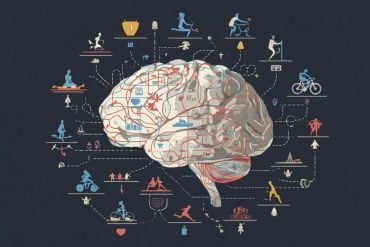Summary: Older adults may have better listening skills in busy social settings than previously believed, researchers say.
Source: Baycrest
Ever grumble about your grandpa’s tendency to cheat during a spirited game of gin rummy; or mutter under your breath when grandma asks you to help clean the table at family dinner? Well, you might want to do it more quietly, because there’s a good chance they can hear you better than you think.
According to a new, joint study by Baycrest and Western University, older adults may have better listening skills in noisy environments than we think. Whether at a crowded family event or a busy restaurant, older adults may enjoy and process conversations better than research has so far suggested.
If so, this would improve their quality of life and help them make meaningful connections with others in similar situations, ultimately reducing their risk of social isolation and – since social isolation is a risk factor for cognitive decline – dementia.
Scientists have long thought that compared to younger adults, older adults seem to be less able to use speech “glimpses” (using the speech they hear more clearly during brief reductions in background noise) to better understand conversations in noisy settings.
However, the Baycrest-Western University study shows that this may only be the case for the relatively boring, disconnected and unnatural sentences that are typically used in laboratory settings, but not for more natural speech. In other words, the difficulties older adults experience when listening to speech in noisy situations of everyday life may be less than long thought.
In the study, published in the journal Scientific Reports, younger and older adult participants listened to engaging stories or disconnected sentences without a clear topic – for example, “Smoky fires lack flame and heat.”

The researchers added two kinds of background noise: one that varied in volume, allowing for glimpses, and one that did not vary. The researchers regularly stopped the speech and background noise to ask the participants to report exactly what they understood. The researchers then calculated how many words were understood correctly.
They found that for more natural speech that mimics speaking in everyday life, such as stories, older adults benefited from speech glimpses as much as, or more than, younger adults. Conversely, they benefited less when listening to disconnected sentences.
“These results suggest that older adults may be better at listening in noisy social settings than has long been thought. Our study also highlights the importance of cognitive and motivational factors for speech understanding. Older adults who do not perform well on listening tasks in lab settings may do better in real-life settings,” says Dr. Björn Herrmann, Baycrest’s Canada Research Chair in Auditory Aging, Scientist at Baycrest’s Rotman Research Institute and the senior author on this study.
With additional funding, Dr. Herrmann and his team could investigate what mechanisms in the brain enable older adults to benefit more from natural speech than disconnected laboratory sentences, and how natural speech could be more extensively used in clinical practice to assess older adults’ hearing.
About this auditory neuroscience and aging research news
Author: Sophie Boisvert-Hearn
Source: Baycrest
Contact: Sophie Boisvert-Hearn – Baycrest
Image: The image is in the public domain
Original Research: Open access.
“Age-related deficits in dip-listening evident for isolated sentences but not for spoken stories” by Björn Herrmann et al. Scientific Reports
Abstract
Age-related deficits in dip-listening evident for isolated sentences but not for spoken stories
Fluctuating background sounds facilitate speech intelligibility by providing speech ‘glimpses’ (masking release). Older adults benefit less from glimpses, but masking release is typically investigated using isolated sentences.
Recent work indicates that using engaging, continuous speech materials (e.g., spoken stories) may qualitatively alter speech-in-noise listening. Moreover, neural sensitivity to different amplitude envelope profiles (ramped, damped) changes with age, but whether this affects speech listening is unknown.
In three online experiments, we investigate how masking release in younger and older adults differs for masked sentences and stories, and how speech intelligibility varies with masker amplitude profile. Intelligibility was generally greater for damped than ramped maskers. Masking release was reduced in older relative to younger adults for disconnected sentences, and stories with a randomized sentence order.
Critically, when listening to stories with an engaging and coherent narrative, older adults demonstrated equal or greater masking release compared to younger adults.
Older adults thus appear to benefit from ‘glimpses’ as much as, or more than, younger adults when the speech they are listening to follows a coherent topical thread.
Our results highlight the importance of cognitive and motivational factors for speech understanding, and suggest that previous work may have underestimated speech-listening abilities in older adults.






